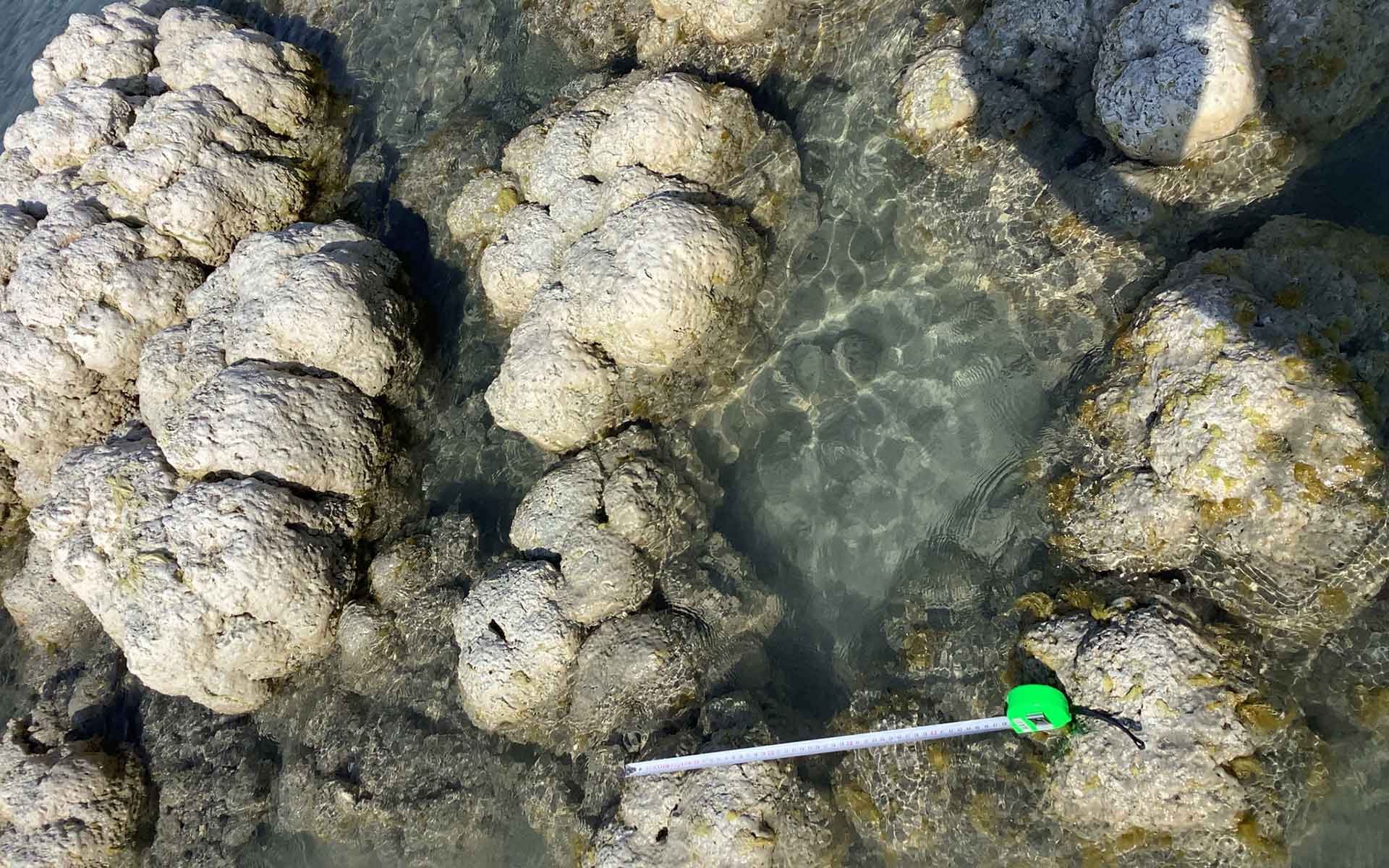
Western shorelines of Lake Salda with older and modern hydromagnesite beaches covering the entire shorelines (Photo by Ali Ihsan Gökçen).
Geological Period
Quaternary
Main geological interest
Stratigraphy and sedimentology
Paleontology
Location
SW Anatolia, Turkey
37°33’09”N, 029°40’53”E
Western shorelines of Lake Salda with older and modern hydromagnesite beaches covering the entire shorelines (Photo by Ali Ihsan Gökçen).
A deep alkaline lake deposits hydromagnesite microbialites that may have clues for possible ancient life on Mars.
NASA recognized Lake Salda as unique and the only compositional and process analog for the Jezero paleolake on Mars. As with Jezero crater, Lake Salda is surrounded by altered and Mg-rich ultramafic terrains, and it contains hydrated Mg-carbonate bearing deposits. Thus, it offers an exceptional setting to investigate the microbially mediated precipitation of hydrated magnesium carbonates in an ultramafic-rich terrain due to the morphological and microbial diversity of microbialites. The study of hydromagnesite microbialites has significant implications for the detection and understanding of similar formations on Mars, providing clues about the potential existence of past life on the Red Planet (Garczynski et al., 2019, 2020).
- Geological description
Lake Salda is a closed alkaline water body (pH>8.4) at 1140 m a.s.l. It has a surface area of ca. 45 km2 and an average depth of 80 m and maximum of 200 m. The lake is surrounded primarily by primitive ultramafic allochthonous rocks Mesozoic in age, and the autochthonous formations are only Quaternary alluvial fans. The stratigraphy of the region reflects the Alpine Orogeny; however, the lake appeared after the Pliocene, according to the lacustrine records. Lake Salda has a rare water chemistry with exceptionally high Mg/Ca ratios from 3 to 7000 (Kazanci et al., 2004; Kaiser et al., 2016; Balci et al., 2020). It is one of the only environments on Earth where extensive microbialites of hydromagnesite [Mg5(CO3)4(OH)2.4(H2O)] are currently forming as mounds that are locally called “white island”. Lake Salda hosts modern, subfossil and fossil microbialites along its perimeter, providing a time capsule for decoding signs of past life. Modern microbialites with different morphotypes (e.g., stromatolite, thrombolite) are currently growing in the shallow (<1 m) and deeper waters (up to 20 m) of the lake and are one of a kind with their rare chemical compositions on Earth and possibly on Mars.
- Scientific research and tradition
Lake Salda’s carbonate stromatolites have been attributed to cyanobacterial and algal activity (Russell et al., 1999). Later, Balci et al. (2022) documented multiple microbialite types in an associated microbial community in the lake. Since recognition of the lake as the best terrestrial analog for the Jezero paleolake on Mars, it has been the center of the international scientific community.
- Reference
Balci, N. et al. (2020) ‘Biotic and Abiotic Imprints on Mg-Rich Stromatolites: Lessons from Lake Salda, SW Turkey’, Geomicrobiology Journal, 37(5), pp. 401–425. Available at: https://doi.org/10.1080/01490451.2019.1710784.
Braithwaite, C.J.R. and Zedef, V. (1996) ‘Hydromagnesite stromatolites and sediments in an alkaline lake, Salda Golu, Turkey’, Journal of Sedimentary Research, 66(5), pp. 991–1002. Available at: https://doi.org/10.1306/D426845F-2B26-11D7-8648000102C1865D.
Garczynski, B.J. et al. (2019) ‘Searching for Potential Biosignatures in Jezero Crater with Mars 2020 — A Spectral Investigation of Terrestrial Lacustrine Carbonate Analogs’, in Ninth International Conference on Mars. LPI Contributions. Ninth International Conference on Mars, California, p. 6302. Available at: https://ui.adsabs.harvard.edu/abs/2019LPICo2089.6302G.
Garczynski, B.J. et al. (2020) ‘Investigating the Origin of Carbonate Deposits in Jezero Crater: Mineralogy of a Fluviolacustrine Analog at Lake Salda, Turkey’, in 51st Lunar and Planetary Science Conference, held 16-20 March, 2020 at The Woodlands, Texas. LPI Contribution. 51st Annual Lunar and Planetary Science Conference, p. 2128. Available at: https://ui.adsabs.harvard.edu/abs/2020LPI….51.2128G.
Kaiser, J. et al. (2016) ‘Sedimentary lipid biomarkers in the magnesium rich and highly alkaline Lake Salda (south-western Anatolia)’, Journal of Limnology, 75(3), pp. 581–596. Available at: https://doi.org/10.4081/jlimnol.2016.1337.
Kazanci, N., Girgin, S. and Dügel, M. (2004) ‘On the limnology of Salda Lake, a large and deep soda lake in southwestern Turkey: future management proposals’, Aquatic Conservation: Marine and Freshwater Ecosystems, 14(2), pp. 151–162. Available at: https://doi.org/10.1002/aqc.609.
Russell, M.J. et al. (1999) ‘Search for signs of ancient life on Mars: expectations from hydromagnesite microbialites, Salda Lake, Turkey’, Journal of the Geological Society, 156(5), pp. 869–888. Available at: https://doi.org/10.1144/gsjgs.156.5.0869.
- Author(s)
Nizamettin Kazancı.
Ankara University, Ankara, Turkey.
Nurgül Balci.
Istanbul Technical University Geological Engineering Dept., Geomicrobiology & Biogeochemsitry Laboratory, Istanbul, Türkiye.


